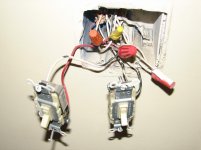capi75rs
Silver Member
Ok, let me see if I have this correct. The light, BEFORE the siding was redone, would come on when either you flip the switch OR if motion was detected in the area of the light. The switch that controls the light is hardwired, ie. looks like a switch that would turn on a light in a closet, and has no remote. AFTER the siding was replaced the "relay" was not reinstalled and ONLY motion will activate the light now. It sounds like you have covered that it is not an RF style switch. So without me being there and going off what is stated, it sounds like you do have an AC relay that was installed to offer you the either/or way of turning on the light. The relay can be wired to operate off the light switch to bypass the motion detector and activate the light. This would allow someone inside the house to go outside and have light to see before they got to the motion detection area. Not knowing how they have wired the relay, I'll tell you it (the relay) can be wired by switching neutral (aka switching ground) or by switching the hot side (120v usually the black wire, if wired by code) The relay you would need is not very expensive @ $10, but could be tricky to connect if you've never wired up one. here is a link to Granger.
Grainger Industrial Supply
As you can see they have thousands of these relays in all different shapes and sizes. You'll need an AC relay for 120v with a 5-10 amp rating which is overkill on amperage IF your only running the motion light. Size is also important so it will fit in the junction box.
The wires comming from the light switch?, is there only one single wire or is it a couple of wires in a sheith ie. like the wires running to an outlet or light. I know of several ways one could wire up the relay and finding out exactley how many wires there are is important.
I have not thought of wiring my motion lights this way, but it is a neat way to have the best of both worlds. Motion and switch control. By chance the fellow you purchased the home from wasn't an electrican was he
Once you decide on a relay you'll need to find out a few things. Mainly what way the relay is activated. If you decide to continue let us know and I'd be happy to give you some points to check. However it may be quicker to have a local electrican come down and install the relay. It would only take about an hour or so, but I have said that before and been 4 hours into a job
Grainger Industrial Supply
As you can see they have thousands of these relays in all different shapes and sizes. You'll need an AC relay for 120v with a 5-10 amp rating which is overkill on amperage IF your only running the motion light. Size is also important so it will fit in the junction box.
The wires comming from the light switch?, is there only one single wire or is it a couple of wires in a sheith ie. like the wires running to an outlet or light. I know of several ways one could wire up the relay and finding out exactley how many wires there are is important.
I have not thought of wiring my motion lights this way, but it is a neat way to have the best of both worlds. Motion and switch control. By chance the fellow you purchased the home from wasn't an electrican was he
Once you decide on a relay you'll need to find out a few things. Mainly what way the relay is activated. If you decide to continue let us know and I'd be happy to give you some points to check. However it may be quicker to have a local electrican come down and install the relay. It would only take about an hour or so, but I have said that before and been 4 hours into a job
